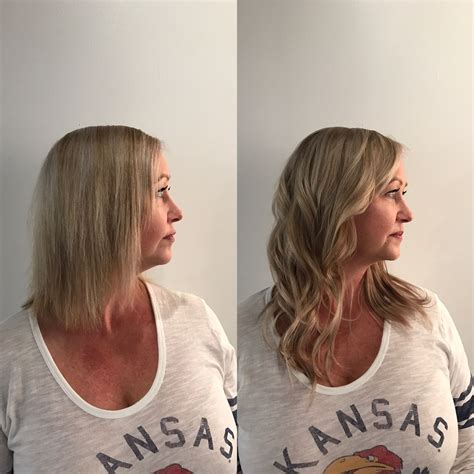With over 16 million hair extensions sold annually, tape-in extensions emerge as the preferred method for a voluminous, natural-looking transformation. But what exactly are they, and how do they work?

Tape-in extensions are thin strips of 100% human hair with a hypoallergenic adhesive strip attached at the top. These strips are then “sandwiched” onto your natural hair, creating a secure and seamless blend.
- Volume and Length: Instantly add fullness and length to your hair, without damaging it.
- Quick and Easy Installation: Takes less than an hour, compared to hours for other methods.
- Low Maintenance: Can be washed and styled like your natural hair, requiring minimal maintenance.
- Versatile: Can be cut, colored, and styled to match your hair perfectly.
Styling Options
Tape-in extensions offer an array of styling options, allowing you to create:
- Sleek and Straight: Use a flat iron to achieve a polished, straight look.
- Curls and Waves: Use a curling iron or wand to add volume and movement.
- Updos: Create elegant updos that hold securely with the added volume of tape-in extensions.
Maintenance Tips
- Brush Regularly: Use a wide-tooth comb to gently brush your hair and remove any tangles.
- Wash with Care: Use sulfate-free shampoo and conditioner to avoid damaging the adhesive.
- Avoid Heat Styling: Limit the use of hot tools and apply heat protectant spray to prevent damage.
- Regular Adjustments: Schedule appointments with your stylist every 6-8 weeks for adjustments and maintenance.
Cost: Tape-in extensions can range in price from $500 to $1,500, depending on the quality, length, and thickness of the hair used.
Safety: When applied professionally, tape-in extensions are considered safe for most hair types. However, it’s essential to consult with a licensed hairstylist to ensure they are suitable for your hair.
Considerations:
- Hair Type: Not suitable for very fine or damaged hair.
- Root Growth: Natural hair growth will cause the extensions to move down, requiring adjustments.
- Adhesive Sensitivity: Some individuals may experience allergic reactions to the adhesive.
Beyond traditional hair extensions, tape-in technology is also used in innovative applications:
- Bangs: Create instant bangs without cutting your hair by using tape-in bangs.
- Tape-in Ponytails: Add length and volume to your ponytail for a glamorous look.
- Corrective Hair Replacement: Fill in gaps or cover hair loss areas using tape-in extensions.
Table 1: Type of Tape-in Extensions
| Name | Description |
|---|---|
| Human Hair | Made from 100% Remy human hair, offering the most natural look and feel. |
| Synthetic Hair | Less expensive than human hair, but less durable and does not adapt to heat styling. |
| Heat-Resistant Fiber | Can withstand heat up to 400 degrees Fahrenheit, allowing for straightening and curling. |
Table 2: Prices and Lengths
| Length (inches) | Average Price |
|---|---|
| 12 | $500-$800 |
| 14 | $600-$900 |
| 16 | $700-$1,000 |
| 18 | $800-$1,100 |
| 20 | $900-$1,200 |
Table 3: Maintenance Schedule
| Service | Frequency |
|---|---|
| Brushing | Daily |
| Washing | 2-3 times per week |
| Heat Styling | Limit to 2-3 times per week |
| Adjustments | Every 6-8 weeks |
Table 4: Customer Motivations
| Motivation | Percentage |
|---|---|
| Desire for Volume and Length | 75% |
| Special Occasion Enhancement | 15% |
| Hair Correction | 10% |
